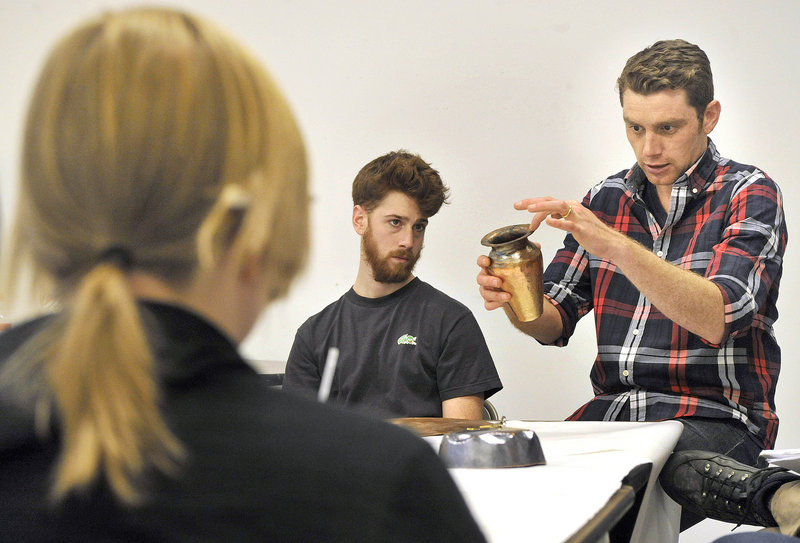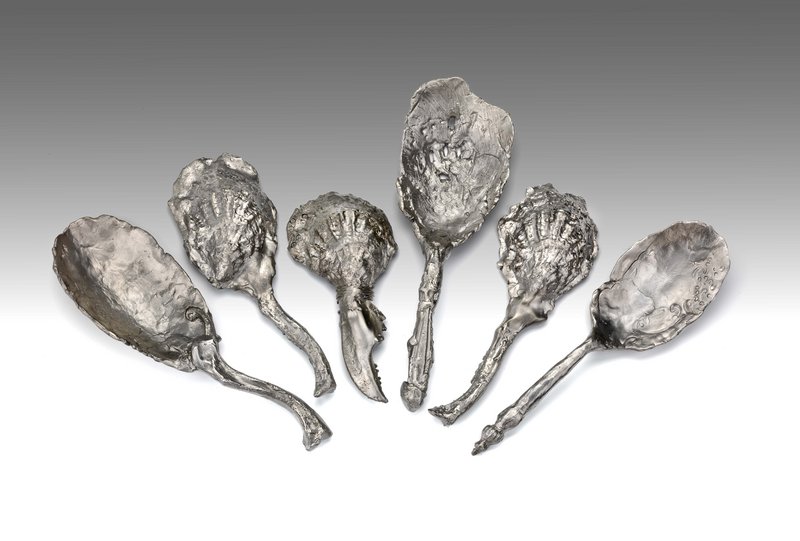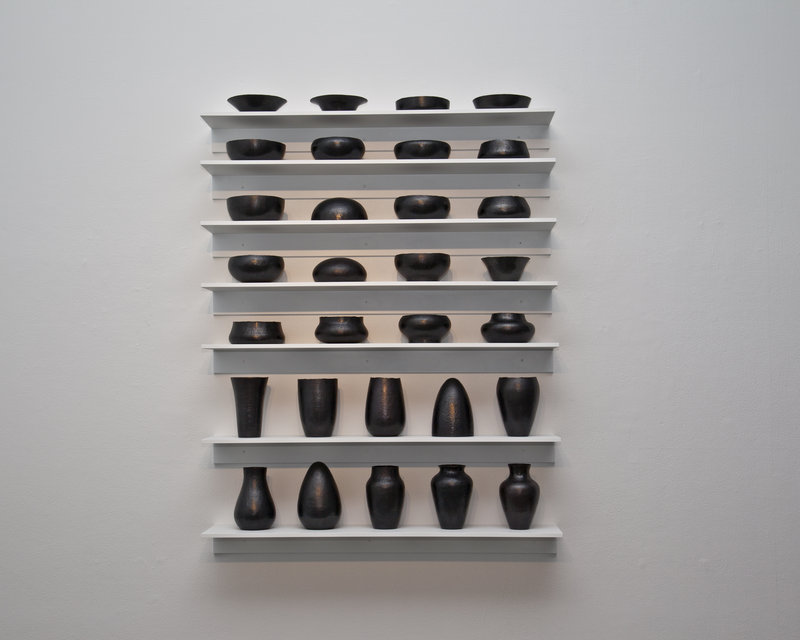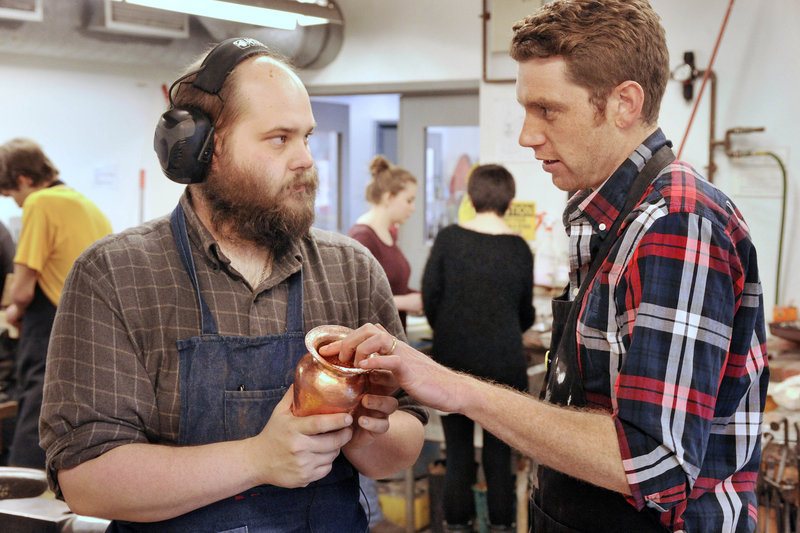Jeffrey Clancy is a busy man, but he had no choice but to pay attention. The message felt emphatic:
“You must submit your materials.”
There was no imploring or suggesting. The message was firm.
It came from a friend — a former professor, no less — and it pertained to a prestigious exhibition at the Renwick Gallery of the Smithsonian American Art Museum in Washington, D.C. The Smithsonian was culling its list of artists to include in its “40 Under 40: Craft Futures” show, and Clancy, a metalsmith from Portland who teaches at Maine College of Art, was on the short list.
He just had to meet the deadline, which loomed the next day.
“I get a lot of emails,” he said over a pint at Dogfish Cafe on Spring Street in Portland. “I ignore most of them. But this one got my attention.”
Clancy did the right thing. He pulled the application materials together and overnighted them to the Smithsonian. Some time later came word that he had been accepted in the show.
In doing so, the Renwick conferred upon Clancy his status as one of the most important young craft artists working in the United States today.
In the simplest of terms, Clancy makes tabletop objects — bowls, cups, various other vessels and seemingly utilitarian objects. But his work is much more complicated, and much more than mere ornamentation. He utilizes familiar motifs and techniques, but in new and unusual ways. He considers historic and contemporary materials, and exploits both to communicate his personal perspective.
A documentary about the show, which closed last month, debuted on the Smithsonian Channel in January.
“40 Under 40” has brought Clancy, who turns 37 in May, attention and financial reward. The Smithsonian purchased several of his pieces for its permanent collection, and raised his profile among collectors.
“The show got tons of press,” Clancy said, “and they used my images in a lot of their advertising and promotion. It was pretty amazing to be recognized. I’m not great at promoting myself, so it was nice to be noticed.”
That is a minor understatement. The exhibition was covered by major art and mainstream publications and programs, including The New York Times, NPR Weekend Edition and American Craft magazine.
INFORMED BY 9/11
The purpose of the show, said gallery director Nicholas Bell, was to feature 40 artists born since 1972, the year the Smithsonian American Art Museum established the Renwick to focus on crafts and decorative arts. Its intent was to investigate evolving notions of craft within traditional media.
Further, all the work chosen for the show was made after Sept. 11, 2001. Bell explained why in an interview with American Craft.
“The role of 9/11 in defining this generation’s world view is critical,” Bell told the magazine. “The oldest artist in this show was 29 at the time of the attacks, the youngest only 17. The dramatic shifts in culture since that day have shaped their adult lives and their careers so far.
“Not surprisingly, the economy and manufacturing are a common subject of interest for this group. And sustainability is an intense focus. Each artist values craft for its prescriptive power — its potential to make life better.”
This exhibition also highlighted strides in the American craft movement since that moment.
The worse things get in the world, Bell said, the more powerful craft becomes, “because creativity thrives on doubt seeping through our culture. And that’s the bottom line: Craft is getting stronger. It’s growing in ways that we would never have imagined in 2000. And its values are being shared by an ever-expanding population.”
In addition to Clancy, the show includes Vivian Beer, a Maine native and MECA graduate now living in New Hampshire.
Clancy has lived in Portland for six years. He came east out of graduate school at San Diego State University for a job as an assistant professor of metalsmithing and jewelry at MECA. He also serves as a visiting lecturer and critic in the jewelry and metals department at Rhode Island School of Design.
Clancy lives on Munjoy Hill with his wife, Marie, and their 2-year-old son. Portland has been good for him, he said, because it is both understanding and supportive of the arts.
“I feel like a lot of things have happened for me because of being in Portland,” Clancy said. “It’s an encouraging community. It’s a community that can cater to a lot of different artistic practices. And it’s a community you can be productive in as well.”
When Clancy arrived in Portland, he maintained a work bench studio in the Artist Studio Building on Congress Street. He loved the interaction with other artists, and enjoyed seeing what his peers and colleagues were up to. Now he focuses his studio practice at MECA and mostly in the summer. Teaching keeps him busy most of the academic year.
In Portland, Clancy’s work was featured at the end of 2012 in a faculty show at the Institute of Contemporary Art at MECA. Gallery director Daniel Fuller said people seemed to appreciate the humor in Clancy’s objects.
Among other things, Clancy makes whimsical and ironic pieces that riff on functional tabletop objects — dinnerware, utensils and that sort of thing. But his pieces are exaggerated and over the top.
“The way he renders them is the opposite of practical,” Fuller said. “With the spoons, for instance, he elevates them and transforms them to the point of absurdity. They are completely pointless at that point.”
Clancy’s humor runs both subtle and deep. Sometimes, he might poke fun at his own field, offering an art-world critique of its self-perceived preciousness. But the inside joke isn’t so exclusive that it’s lost on everyday folks, Fuller said.
That’s a fine line, and Clancy seems to toe it well. “He gives just enough to let the public in,” Fuller said.
Longtime friend David Clemons said Clancy’s niche is his ability to take traditional forms and techniques and the practices that surround them, and put a contemporary twist on them.
“The forms are more current, but at the root has always been this investigation of this historical body of work,” said Clemons, who went to graduate school with Clancy in San Diego and now teaches metalsmithing at the University of Arkansas in Little Rock.
“Jeff’s work promotes a continuation of the use of the hand and the appreciation of the hand,” he said. “Jeff is still working with a utilitarian object, and yet the way he renders them, it’s not something that will go right on somebody’s dining room table. It’s most likely going to be purchased by collectors or galleries or museums.”
Fuller said it’s important not to pigeonhole Clancy as a Portland artist, or even a Maine artist. His world is much larger. He just happens to live here.
“He is unique in Portland, but he is unique in the country too. He gets press and gets recognition in Portland, but far beyond it too. That’s what ’40 Under 40′ was all about. It was about the best and most important craft artists working in the country today,” Fuller said.
That point was hammered home for Fuller when he attended a contemporary curator’s conference in Boston last year. “Everyone in that field knew MECA because of Jeffrey,” he said.
A LOVE OF TEACHERS, TEACHING
Clancy’s foray in the arts began in high school. He took some art classes in school growing up in Pennsylvania, then enrolled in a tiny state college, Kutztown University in Kutztown, Pa. He wasn’t a great student, and found himself drawn to subjects he liked and felt comfortable studying.
Among them was metalsmithing and jewelry making. He liked the teacher and enjoyed working with his hands. The act of hammering and raising metal from a sheet to a functional object entranced him.
“I was good at it, but I had to work. I do not think I had natural ability, but I’m good with my hands and I have a good work ethic,” he said.
Because of the teachers who mentored and continue to mentor him, Clancy reveres the art and practice of teaching, and strives to inspire students to achieve more than they might think possible. He likes to tell his students, “Learning is ugly. Deal with it.”
Nothing comes gift-wrapped in education. What you get out of it is what you put in, he tells them.
“I don’t need talented students. I don’t need intellectually rigorous students. I need hard-working students,” he said.
That work ethic is what set Clancy apart when Bell began sifting through a mountain of applications, resumes and images as he selected what he considered to be the 40 best and most interesting young craft artists working today.
“The most critical factor was that the work had to be strong; it had to grab me,” Bell has said. “When you sit down to review hundreds of candidates, you pull out those whose work stops you from moving to the next page — whom you recall above the rest, whom you want to know more about.”
Staff Writer Bob Keyes can be contacted at 791-6457 or:
bkeyes@pressherald.com
Twitter: pphbkeyes
Send questions/comments to the editors.







Success. Please wait for the page to reload. If the page does not reload within 5 seconds, please refresh the page.
Enter your email and password to access comments.
Hi, to comment on stories you must . This profile is in addition to your subscription and website login.
Already have a commenting profile? .
Invalid username/password.
Please check your email to confirm and complete your registration.
Only subscribers are eligible to post comments. Please subscribe or login first for digital access. Here’s why.
Use the form below to reset your password. When you've submitted your account email, we will send an email with a reset code.